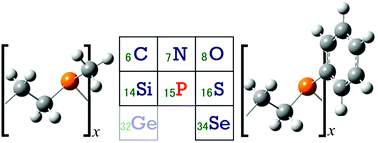Conformational characteristics and configurational properties of poly(1-methylphosphirane) (PMePP) and poly(1-phenylphosphirane) (PPhPP) have been predictively elucidated by the refined rotational isomeric state scheme coupled with ab initio molecular orbital and density functional calculations. The lone pair of the phosphorus atom adopts an sp hybrid orbital. Owing to the high s character (50%), the polyphosphiranes exhibit low proton (hydrogen) affinities, and hence the lone pair does not form any intramolecular attractive interactions with hydrogen. As the meso-diad probability varies from 0 (syndiotactic) to 1 (isotactic), the characteristic ratio of PMePP slightly increases from 6.7 to 7.4, whereas that of PPhPP considerably decreases from 38 to 7.3. The large dimension of syndiotactic PPhPP is chiefly due to π–π attractions formed between adjacent phenyl groups. The trivalent phosphorus atom may be bonded to heavy, noble, and transition metals but readily or gradually oxidized. The usefulness and necessity of the polyphosphiranes have been assessed.

You have access to this article
 Please wait while we load your content...
Something went wrong. Try again?
Please wait while we load your content...
Something went wrong. Try again?


 Please wait while we load your content...
Please wait while we load your content...